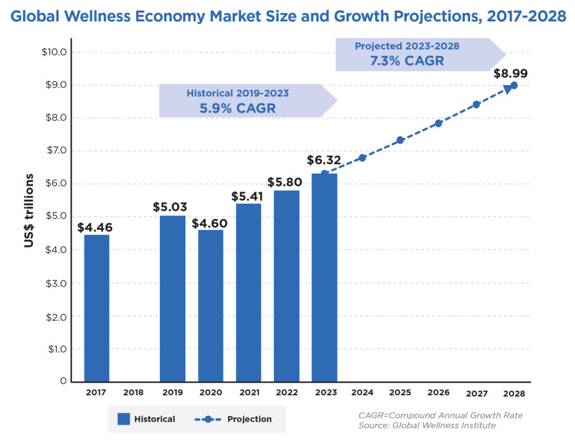In the incredibly saturated market of health and wellness, GoodRx bylined an article that was resonant enough to leap beyond the bounds of its company blog and into hundreds of media outlets with the click of a button, scoring over 268 pickups.
GoodRx’s story on prescription unaffordability shows that, in a time when visibility is a commodity, it's still very possible to stand out and gain authority in the growing $2 trillion health and wellness market.

Source: Global Wellness Institute
Marketing fatigue is real in this space, as bogus claims and politicized advice fight for visibility in the algorithm alongside legit scientific research. Audiences are tired of overly salesy branded content. And understandably, brands are rethinking investments in PR and SEO strategies that have become less predictable in driving results.
To break through one of the most crowded markets, brands need smarter storytelling and distribution. Brands with earned reach strategies can differentiate themselves from AI-generated content, increase the likelihood of being cited in AI output, and generate more highly-qualified sales leads.
What Major Brands are Doing to Bulk Up Their Authority
AI’s influence has finally killed the temptation of using bulked-up vanity metrics to indicate brand awareness. While website visits are down with the rise of zero-click search results and AI overviews, some brands are noticing that those that do are more engaged and likely to buy.
AEO is thankfully helping separate the fluff from credible and authoritative content, and brands that want to compete in this space are building authority by owning topics with an ecosystem of interlinked content that shows they know their stuff.
Service Journalism: Brand-Supported, News You Can Use
Health and wellness brands that are making a mark today are generating original content and leveraging datasets that can’t be easily replicated. Their noteworthy content is backlink-worthy and newsworthy enough to get news domains to cite their findings — which still helps traditional SEO — and also increases the likelihood of being cited by AI.
Service journalism — “news you can use” — often features tips for readers and has been the brand strategy de jour for a while. In health, early adopters like Blue Cross Blue Shield built authority this way by offering research-driven insights rooted in credibility rather than sales.
Now, GoodRx, MyFitnessPal, and Hers are on this brand journalism bandwagon — and adding the extra element of widespread distribution.
Exponential Amounts of Eyeballs with Earned Reach
Instead of brand editorial simply being siloed onto their owned channels or through PR, these brands are scaling their stories with earned reach platforms.
Publishers are eating it up.
Thousands of news domains are signed up to Stacker’s platform which makes republishing brand journalism on their news domains simple. It simultaneously builds trustworthy links back to these brands’ websites, and voila — they’re far more likely to rank higher in traditional search.
When brands rinse and repeat this strategy, they signal to AEO that their content is authoritative and credible enough to gain many third-party citations.
The Nitty-Gritty of Why These Brand Stories Scale
Here’s how some influential health and wellness brands are stepping up their game on PR and search, and why it works:
💊 More Americans Than Ever Are Struggling to Afford Their Prescription Medications by GoodRx generated 268 media pickups for good reason. They appealed to 67% of Americans who have a prescription and described its cost as a burden. The piece was moving, showing what aspects of life some of these people couldn’t afford because of their medication prices — and how 13% are choosing to go without a medication entirely due to its cost. The piece feels like a call to action for politicians while giving a “you are not alone” undertone to cash-strapped patients.
☕ Caffeine use disorder: When your energy fix becomes unhealthy by Rula Health tackled the issue of caffeine addiction and dependence — relatable for many Americans — with a vigorously researched and clinically reviewed article. In addition to handy sections, like a symptom list for caffeine use disorder, the article weaves in academic studies, and ways to curb caffeine intake. This well-rounded story builds authority with its original quotes from credible sources and increases trustworthiness with its transparent fact-checking process. It's no wonder that it earned 206 pickups.
📍 Top 10 US destinations for fitness lovers to visit by Hers used examined already-available data on cities and used their own methodology to rank cities by fitness or weight loss/management opportunities ranging from walkability, to number of sports fields, and days of precipitation each year. Not only did Hers pull their analysis into fun infographics and key findings, but the story was share-worthy for people looking to move, etc. This article racked up 225 pickups, including Yahoo, AOL, and the Miami Herald.
We unpack more brand journalism that worked well here.
Don’t miss out on one of the best ways to reach audiences with authenticity and boost awareness. Request a demo by clicking below.